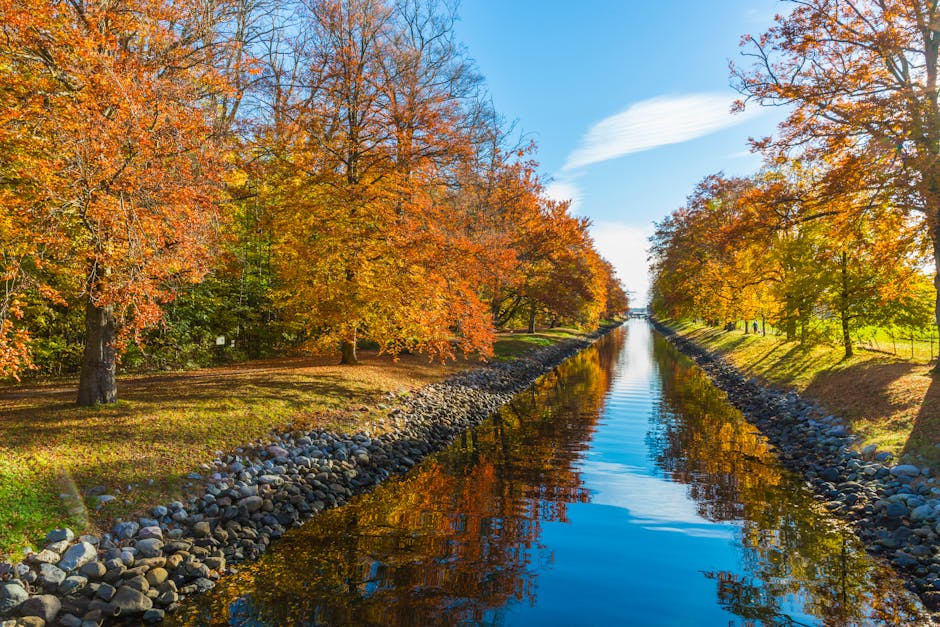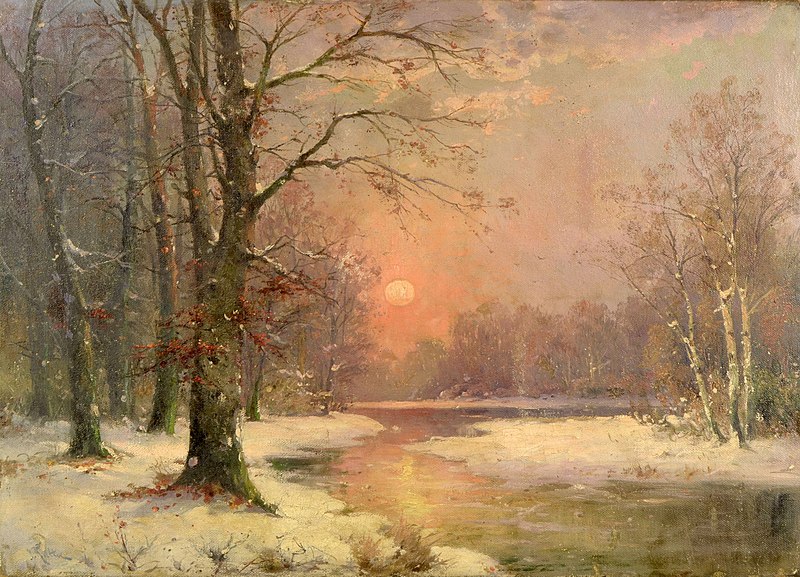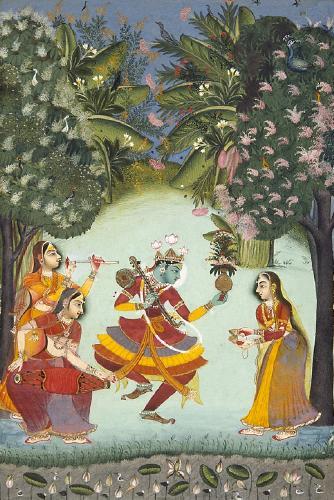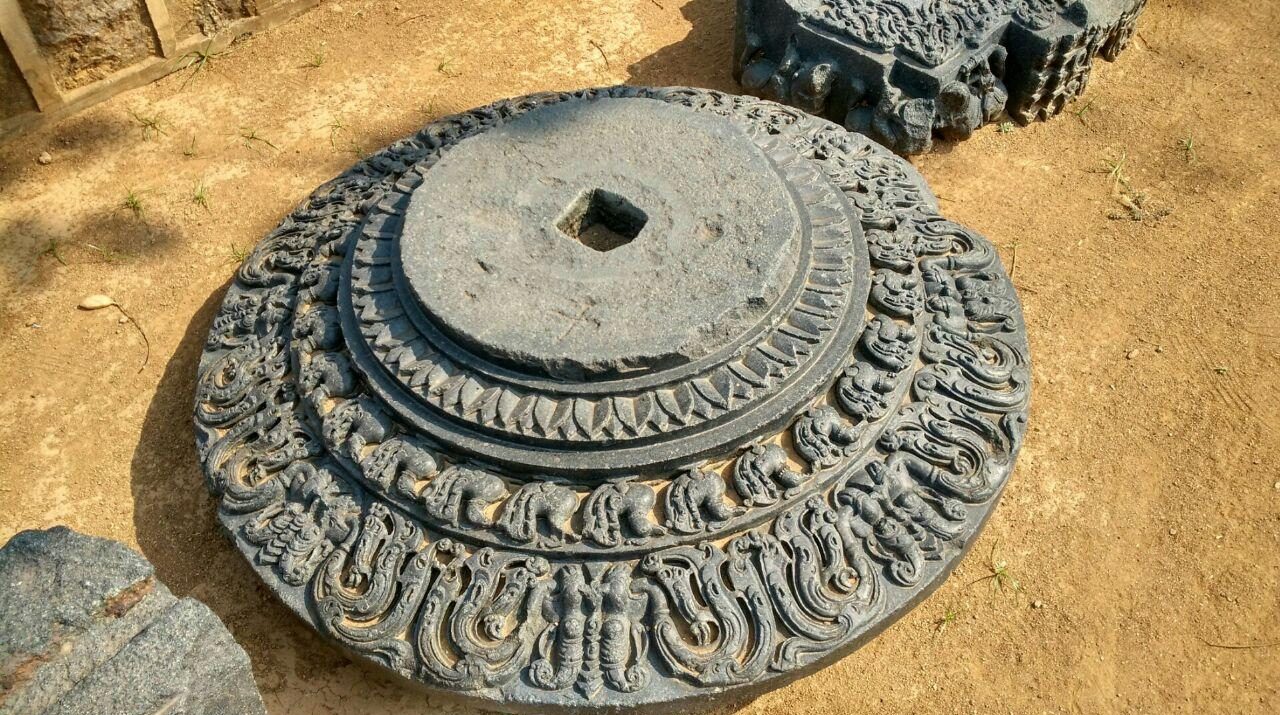An epic poem by the celebrated poet of ancient India, Kalidasa from the Gupta era about the six seasons of India. A vivid, sensual and with frankly erotic undertones, it is a work abounding with the shringara rasa. This rasa is believed to be the source of all the other rasas; totally nine in number. The shringara rasa includes the feelings of erotic love,song, dance and decoration. Ritu means seasons and samhara means a group or compilation. A better translation of Ritusamhara would be a medley of seasons or a garland of seasons. Ritusamhara has been translated into English, Tamil, Marathi etc.
An early work of Kalidasa; though sometimes its authorship has been challenged. The six seasons portrayed are the grishsma, summer, the varsha or rains, sharat or autumn, hemanta or early winter, shishira or winter and vasanta the spring season. The poet has set lovers ,animals and the separated against the backdrop of nature in different seasons. The sensuality of the work is very raw; the moods captured by the poet in a primal form. Every canto ends with a blessing or benediction !

Summer,landscape painting.
By Henri Biva (Christie’s London) [Public domain], via Wikimedia Commons
The poet describes the summer season or grishma first. The description is vivid with references to the searing heat and its effect on human beings and animals. The animals are thirsty, the men lacking in longing for their beloved and the separated looking up to the sky. The women are trying to rekindle passion in their lovers by various means.
ससीकराम्भोधरमत्तकुञ्जरस्तडित्पताकोऽशनिशब्दमर्दलः ।
समागतो राजवदुद्धतद्युतिर्घनागमः कामिजनप्रियः प्रिये ।। २.१ ।।
नितान्तनीलोत्पलपत्त्रकान्तिभिः क्वचित्प्रभिन्नाञ्जनराशिसंनिभैः ।
क्वचित्सगर्भप्रमदास्तनप्रभैः समाचितं व्य्ॐअ घनैः समन्ततः ।। २.२ ।।
तृषाकुलैश्चातकपक्षिणां कुलैः प्रयाचितास्तोयभरावलम्बिनः ।
प्रयान्ति मन्दं बहुधारवर्षिणो बलाहकाः श्रोत्रमनोहरस्वनाः ।। २.३ ।।
बलाहकाश्चाशनिशब्दमर्दलाः सुरेन्द्रचापं दधतस्तडिद्गुणं ।
सुतीक्ष्णधारापतनोग्रसायकैस्तुदन्ति चेतः प्रसभं प्रवासिनां ।। २.४ ।।
प्रभिन्नवैडूर्यनिभैस्तृणाङ्कुरैः समाचिता प्रोत्थितकन्दलीदलैः ।
विभाति शुक्लेतररत्नभूषिता वराङ्गनेव क्षितिरिन्द्रगोपकैः ।। २.५ ।।
The rains or the Varsha ritu is depicted full of energy. The earth has come to life with thunder and lightning and rivers full of water speeding towards the oceans. Forests are green and verdant. Women hurry to meet their lovers bedecked with flowers and perfume. The separated lovers gaze at the clouds with dismay and longing.
सुवासितं हर्म्यतलं मनोहरं प्रियामुखोच्छ्वासविकम्पितं मधु ।
सुतन्त्रिगीतं मदनस्य दीपनं शुचौ निशीथेऽनुभवन्ति कामिनः ।। १.३ ।।
नितम्बबिम्बैः सदुकूलमेखलैः स्तनैः सहाराभरणैः सचन्दनैः ।
शिरोरुहैः स्नानकषायवासितैः स्त्रियो निदाघं शमयन्ति कामिनां ।। १.४ ।।
नितान्तलाक्षारसरागरञ्जितैर्नितम्बिनीनां चरणैः सनूपुरैः ।
पदे पदे हंसरुतानुकारिभिर्जनस्य चित्तं क्रियते समन्मथं ।। १.५ ।।
पयोधराश्चन्दनपङ्कचर्चितास्तुषारगौरार्पितहारशेखराः ।
नितम्बदेशाश्च सहेममेखलाः प्रकुर्वते कस्य मनो न सोत्सुकं ।। १.६

Eager maiden in the rain, abhisarika nayika,painting,18th century, Nurpur, Himachal Pradesh,LACMA,USA.
See page for author [Public domain], via Wikimedia Commons

Rain,image.

Painting by Sobha Singh,20th century.
By India4art – Own work, CC BY-SA 3.0, https://commons.wikimedia.org/w/index.php?curid=28320346
Sharat ritu or autumn has arrived and the rivers have slowed down. The sky has few clouds and the moons glows clearly. Cool breezes blow and the beautiful maidens watch the scene in delight. They wear jasmine in their hair.
व्योम क्वचिद्रजतशङ्खमृणालगौरैस्त्यक्ताम्बुभिर्लघुतया शतशः प्रयातैः ।
संलक्ष्यते पवनवेगचलैः पयोदै राजेव चामरशतैरुपवीज्यमानः ।। ३.४ ।।
भिन्नाञ्जनप्रचयकान्ति नभो मनोज्ञं बन्धूकपुष्परजसारुणिता च भूमिः ।
वप्राश्च पक्वकलमावृतभूमिभागाः प्रोत्कण्ठयन्ति न मनो भुवि कस्य यूनः ।। ३.५ ।।
मन्दानिलाकुलितचारुतराग्रशाखः पुष्पोद्गमप्रचयक्ॐअलपल्लवाग्रः ।
मत्तद्विरेफपरिपीतमधुप्रसेकश्चित्तं विदारयति कस्य न कोविदारः ।। ३.६ ।।
तारागणप्रवरभूषणमुद्वहन्ती मेघावरोधपरिमुक्तशशाङ्कवक्त्रा ।
ज्योत्स्नादुकूलममलं रजनी दधाना वृद्धिं प्रयात्यनुदिनं प्रमदेव बाला ।। ३.७ ।।
कारण्डवाननविघट्टितवीचिमालाः कादम्बसारसकुलाकुलतीरदेशाः ।
कुर्वन्ति हंसविरुतैः परितो जनस्य प्रीतिं सरोरुहरजोऽरुणितास्तटिन्यः ।। ३.८ ।।

Autumn, image.
Source ; pexels.com
Hemanta or early winter comes and the rice is harvested. Women don’t find lotuses; they use sandalwood paste on their bodies and use fragrant waters in their hair. They come together with their lovers at night. Women show signs of the night’s passion in the morning with tousled hair and sleeping till the sun rises spreading its warmth.
Shishira is winter and it is very cold. People decide to stay indoors. Harvested rice lies on the floor. Snow fall also happens in some places. Lovers drink wine and after a night of lovemaking women emerge like goddesses; says the poet. their hair is freshly washed and after decorating their faces they begin the day.
पाकं व्रजन्ती हिमजातशीतैराधूयमाना सततं मरुद्भिः ।
प्रिये प्रियङ्गुः प्रियविप्रयुक्ता विपाण्डुतां याति विलासिनीव ।। ४.११ ।।
पुष्पासवामोदसुगन्धिवक्त्रो निःश्वासवातैः सुरभीकृताङ्गः ।
परस्पराङ्गव्यतिषङ्गशायी शेते जनः कामरसानुविद्धः ।। ४.१२ ।।
दन्तच्छदैः सव्रणदन्तचिह्नैः स्तनैश्च पाण्यग्रकृताभिलेखैः ।
संसूच्यते निर्दयमङ्गनानां रतोपभोगो नवयौवनानां ।। ४.१३ ।।
काचिद्विभूषयति दर्पणसक्तहस्ता बालातपेषु वनिता वदनारविन्दं ।
दन्तच्छदं प्रियतमेन निपीतसारं दन्ताग्रभिन्नं अवकृष्य निरीक्षते च ।। ४.१४ ।।

Winter, painting.
Adolf Kaufmann [Public domain], via Wikimedia Commons
Spring or Vasanta ritu has been personified as a ”he” by the poet. ‘He’ touches and transforms everything. Nature.Humans. Ponds are full of water.Lotuses bloom. Trees are flowering. Women wear bright clothes,flowers,pearlstrings, bangles and anklets. Bees are humming. the soud of the koel (cuckoo bird) is very appealing. Lovers are busy with each other, as described by the poet.
सुगन्धिनिःश्वासविकम्पितोत्पलं मनोहरं कामरतिप्रबोधकं ।
निशासु हृष्टा सह कामिभिः स्त्रियः पिबन्ति मद्यं मदनीयमुत्तमं ।। ५.१० ।।
अपगतमदरागा योषिदेका प्रभाते कृतनिबिडकुचाग्रा पत्युरालिङ्गनेन ।
प्रियतमपरिभुक्तं वीक्षमाणा स्वदेहं व्रजति शयनवासाद्वासमन्यं हसन्ती ।। ५.११ ।।
अगुरुसुरभिधूपामोदितं केशपाशं गलितकुसुममालं कुञ्चिताग्रं वहन्ती ।
त्यजति गुरुनितम्बा निम्ननाभिः सुमध्या उषसि शयनमन्या कामिनी चारुशोभां ।। ५.१२ ।।
कनककमलकान्तैश्चारुताम्राधरोष्ठैः श्रवणतटनिषक्तैः पाटलोपान्तनेत्रैः ।
उषसि वदनबिम्बैरंससंसक्तकेशैः श्रिय इव गृहमध्ये संस्थिता योषितोऽद्य ।। ५.१३ ।।
प्रफुल्लचूताङ्कुरतीक्ष्णसायको द्विरेफमालाविलसद्धनुर्गुणः ।
मनांसि भेत्तुं सुरतप्रसङ्गिनां वसन्तयोद्धा समुपागतः प्रिये ।। ६.१ ।।
द्रुमाः सपुष्पाः सलिलं सपद्मं स्त्रियः सकामाः पवनः सुगन्धिः ।
सुखाः प्रदोषा दिवसाश्च रम्याः सर्वं प्रिये चारुतरं वसन्ते ।। ६.२ ।।
ईषत्तुषारैः कृतशीतहर्म्यः सुवासितं चारुशिरश्च चम्पकैः ।
कुर्वन्ति नार्योऽपि वसन्तकाले स्तनं सहारं कुसुमैर्मनोहरैः ।। ६.३ ।।
वापीजलानां मणिमेखलानां शशाङ्कभासां प्रमदाजनानां ।
चूतद्रुमाणां कुसुमान्वितानां ददाति सौभाग्यमयं वसन्तः ।। ६.४ ।।

Vasant ragini,Ragamala, Rajput, Kota, Rajasthan. 1770.
By Anonymous [Public domain], via Wikimedia Commons
Mural,Ajanta caves,Maharashtra.
By Indischer Maler des 6. Jahrhunderts – The Yorck Project: 10.000 Meisterwerke der Malerei. DVD-ROM, 2002. ISBN 3936122202. Distributed by DIRECTMEDIA Publishing GmbH., Public Domain, https://commons.wikimedia.org/w/index.php?curid=153070

Mithila painting.
By Mithiart.com (Own work) [CC BY-SA 3.0 (http://creativecommons.org/licenses/by-sa/3.0)%5D, via Wikimedia Commons
Source of Sanskrit text : sa.wikisource.org
References :
- Kalidasa;Ritusamhara (The garland of seasons/Rajendra Tandon,tr. New Delhi :Rupa and Co, 2008.
- indianetzone.com
Posted by :
Soma Ghosh
 author
author




